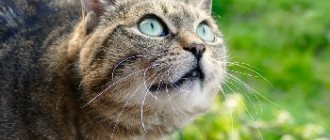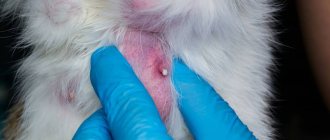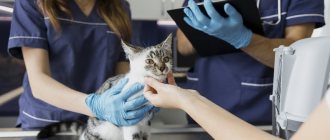- Classification and reasons
- Symptoms of epilepsy in cats
- Diagnostic measures
- Principles of treatment
- First aid
- Drug treatment
Epileptic disease is a serious pathology of the nervous system, namely the brain. It manifests itself as seizures (or their equivalents). Epilepsy in cats is not one of the most common diseases, so its first symptoms take most owners by surprise. Awareness of the clinical picture and first aid skills during attacks is a necessary minimum for effective treatment and prevention of complications in a pet.
Classification and reasons
Epileptic seizures in cats are divided into idiopathic (primary epilepsy) and symptomatic (secondary).
Idiopathic epilepsy is congenital and is caused by genetic abnormalities. Its exact cause is difficult to determine; seizures begin at an early age and are difficult to treat.
The symptomatic (acquired) form appears in adult animals and indicates other diseases.
- Organic brain damage ranks first among the causes of secondary epilepsy in cats. This could be trauma, tumor, infectious pathology (meningitis, encephalitis), exposure to parasites.
- Chronic diseases of other organs also provoke seizures. We are talking about severe dysfunction of the liver, kidneys, and heart.
- Reaction to medications.
- Exposure to toxic substances.
- Metabolic disorders caused by improper feeding (frequent consumption of raw fish).
Secondary epilepsy in cats can be treated well (if its true cause is identified and eliminated).
Cats at risk
Although epilepsy can occur in any cat, it most often affects:
- animals with a similar disease in their pedigree;
- kittens whose mothers suffered a serious illness during pregnancy;
- kittens obtained from close relatives;
- survivors of chemical poisoning;
- have had infections, often with complications;
- cats that have been injured or stressed during pregnancy.
There is no age interval for the onset of the disease - seizures occur in kittens and adult cats.
Symptoms of epilepsy in cats
The main manifestation of the disease is an epileptic seizure. It can proceed in different ways:
- the pet convulses (clonic convulsions) - flails its paws, jerks its head sharply;
- the cat takes an unnatural body position caused by excessive muscle tension (tonic spasms);
- the animal freezes and stares motionlessly into space.
“Classic” attacks are accompanied by the cat falling, salivation, involuntary bowel movements and urination. They last from 10 seconds to several minutes.
In most cases, seizures are preceded by a period of warning signs (“aura”). At this time, the animal becomes restless, loses orientation, makes strange loud sounds, and wants to hide. The aura lasts no more than 10 minutes.
In the post-attack period, the cat may remain disoriented, lethargic and drowsy for some time (from several minutes to several hours), or, conversely, aggressive.
If the attacks are repeated continuously and the animal does not regain consciousness, we are talking about status epilepticus. This is an emergency condition that requires qualified assistance. Epistatus threatens irreversible brain damage and even the death of the pet.
Caring for a cat during an attack
When an epileptic seizure occurs, it is necessary to protect the animal from injury during seizures, which may not respond to treatment subsequently.
- The animal's body must not be restrained. The muscles are maximally tense during an attack; restriction of movements can lead to rupture of ligaments and muscles or even fractures of the limbs.
- Turn your head to one side and place a blanket under it. This will prevent impact injuries and the possibility of saliva getting into the lungs.
- Do not put fingers or foreign objects into the mouth. The statement that an animal can develop asphyxia as a result of a recessed tongue is a myth; its muscles are tense, like the rest of the muscles of the whole body. And the introduction of foreign objects or hands into the mouth can lead to broken teeth or injury to a finger when inserted into the mouth.
- Remove any dangerous objects within the radius of the animal having an attack.
Diagnostic measures
As soon as your cat exhibits its first seizure, it should be taken to an experienced veterinarian. In addition to the examination, your pet will need a comprehensive examination.
- Laboratory tests of blood and urine.
- Electroencephalography (a specific method for studying brain potentials).
- MRI or CT scan of the brain (detects organic damage, hematomas, tumors).
- Ultrasound diagnostics of internal organs,
- ECG.
The examination is aimed, first of all, at establishing the cause of the disease. Its results make it possible to answer the question: is epilepsy in cats curable or not. If the provoking factor is not found and a diagnosis of idiopathic epilepsy is made, the prognosis for recovery is questionable.
Diagnosis of epilepsy
During diagnosis, the cause of the development of such a condition is first determined. This is necessary to select an effective treatment regimen. It is important to identify the precursors that provoked the attack (loud sound, stressful situation, moon phase, etc.). To determine this relationship, the following information is timed:
- date of first appearance;
- duration;
- the nature of each attack (are they the same or different, how do they differ);
- frequency of appearance;
- feeding dependence;
- whether there were certain weather events, whether medications were given;
- any other unusual phenomena that do not happen to a cat every day, for example, the first trip to the country.
The doctor will need to provide a video recording of the attack so that the specialist can see exactly what the cat's owners are talking about.
Special studies are also being carried out:
- general and biochemical blood and urine tests to exclude infectious processes in the body and non-infectious processes in the liver and kidneys;
- ultrasound examination of the abdominal organs;
- MRI.
Video: seizures in cats
First aid
As soon as you notice signs of impending seizures, protect your animal by:
- remove from the window, stairs (so that the cat does not fall from a height);
- Place in a space free of objects that could cause injury.
During the attack itself, you should not interfere (the cat may scratch). There is no need to try to pull out its tongue: contrary to popular belief, the animal will not be able to choke itself with it during a seizure. It is advisable to film the course of the seizures - this is useful information for the attending physician. After an attack, provide your pet with peace and eliminate irritants (bright light, noise).
How to stop epilepsy attacks
The appearance of an epileptic attack in a cat is no reason for the owner to panic. We need to get together and provide first aid. The main actions of a cat owner during an attack:
- Laying the animal on a hard surface in a side position. It is advisable to lay something thick and soft to prevent possible head injury during an attack.
- Gently hold the animal's head with your hand, while simultaneously paying attention to changes in saliva (possible appearance of foam or blood impurities). This indicates that the animal has damaged its tongue, lip or buccal mucosa.
- At home, during exacerbation of epilepsy, doctors do not recommend self-treatment with drugs. It is not advisable to try to force a cat to drink.
It is also the owner’s mistake to use force against the animal during an attack. Trying to pin a cat to the floor during an epileptic seizure in an attempt to stop the convulsions will not achieve positive results. A cat can not only bite the owner, but also receive serious injuries. Only a veterinarian after a thorough examination can completely stop attacks or reduce their manifestation to a minimum.
Drug treatment
Treatment of epilepsy in cats with drugs must be agreed with a veterinarian. If attacks are rare (no more than one per month), medications are not required. In other cases, specific medications with anticonvulsant effects, magnesium preparations, and B vitamins are prescribed.
The dose is selected individually. The drugs are taken for a long time (in the case of idiopathic epilepsy - lifelong therapy). Unauthorized cessation of treatment is fraught with progression of the pathology.
In case of secondary epilepsy, the cause that provoked the disease is eliminated: the tumor is removed, the infectious disease is treated, and the metabolism is corrected.
The joint efforts of the owner and the veterinarian significantly improve the quality of life of a sick animal.
Description of the disease
Epilepsy in animals is similar to a similar disease in humans.
It appears suddenly: the cat, for no apparent reason, begins to worry, walk or run around the room aimlessly, then the look becomes absent, the animal falls, and begins to convulse. A clear sign is the appearance of white foam in the corners of the mouth, sometimes mixed with blood. The attack lasts no more than 5 minutes, then the animal gradually comes to its senses and returns to normal life. Epilepsy is controlled with medications. The animal will be able to lead a normal life. Regular examination by a doctor is necessary.
Prevention
What should be done for preventive purposes:
- Vaccinate kittens against diseases that can cause epilepsy.
- Protect the animal from contact with poisonous and toxic substances as much as possible. Including chemicals for cleaning the apartment.
- Do not leave your pet unattended.
- It is worth protecting your pet from stressful situations. For example, collisions with a dog.
All this cannot give an absolute guarantee that epilepsy will bypass the cat, but it will help to significantly reduce the risk of developing the disease.
How it manifests itself
The first thing that comes to mind is, of course, cramps. But this is only one (albeit the most striking) manifestation.
The mechanism of the attack is divided into three phases, which differ in their characteristics.
The first is the stage of short-term precursors , which, due to its transience, may not be noticed. At this time, the cat becomes restless and seemingly absent-minded (does not react to sounds or light), perhaps even shy.
Having caught this moment, you will notice that the muscles begin to twitch slightly, and the head is tilted to the side - the pet briefly loses coordination.
The next phase involves more serious convulsions . They are easy to spot:
- the muscles begin to contract rapidly, and the paws begin to twitch;
- saliva and foam come out of the mouth in large quantities;
- breathing becomes intermittent (after listening, you can identify a clear synchronized wheezing or groan);
- heart beats faster;
- uncontrolled release of urine or feces is possible;
- in some cases it even reaches the point of loss of consciousness.
This picture can be observed for several minutes (or even half an hour), after which the recovery . This means that within 5 minutes after the peak of the exacerbation the animal will be very weak and a little “lost” - this phase is characterized by prostration and disorientation in a familiar environment. After the specified time has passed, the purr returns to normal and runs to the bowl to eat or drink water.
Did you know? Cats excrete sweat through their paws—unlike humans, they do not have sweat glands throughout their bodies.
Note that here is a classic list of the main symptoms and phases. In practice, the boundaries between stages are often blurred. The same applies to the frequency of the attack: it can be repeated several times a day or occur once a month.
In any case, owners should know what to do if their beloved cat’s epilepsy has reached its peak form.
Important! Any attack, regardless of its duration, can be a reason to visit a doctor. Even a convulsion of a few seconds, if repeated frequently, will result in a lack of oxygen for brain cells.











